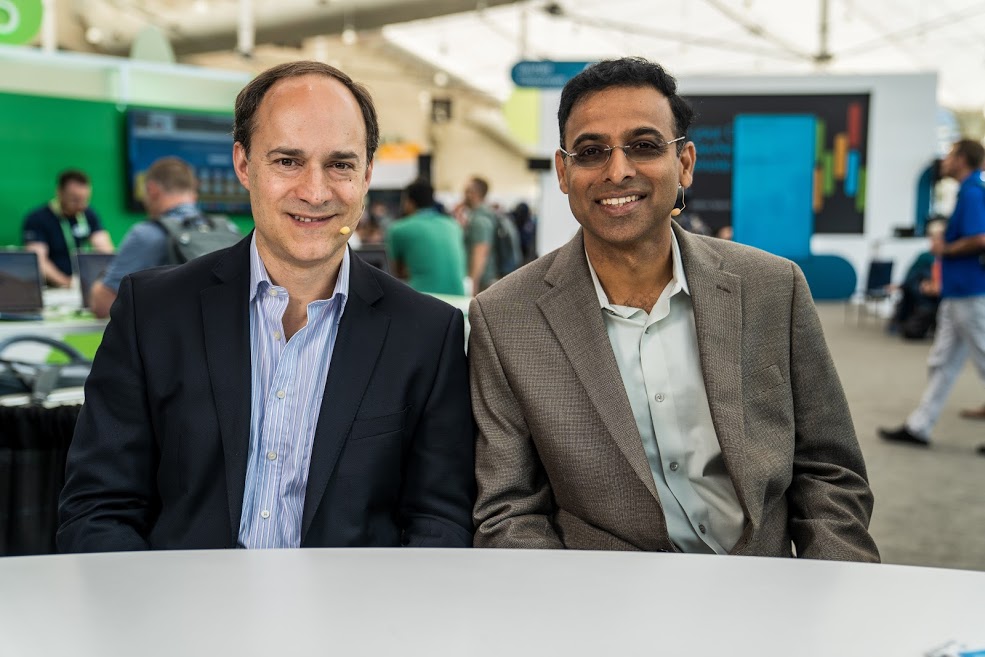 CLOUD
CLOUD
 CLOUD
CLOUD
 CLOUD
CLOUD
Chief information officers and air traffic controllers have a lot in common.
At any given time, controllers at the world’s busiest airports must account for planes in the sky trying to land, planes seeking to take off, the positioning of aircraft on the runways, and external factors, such as wind or bad weather.
Today’s CIO is focused on users, devices, applications and data, all either connected to or moving through network systems at warp speed. It’s an ever-changing puzzle, and Cisco Systems Inc. believes it can help CIOs navigate this complex picture through multidomain architecture based on an understanding of how companies want to build and manage networks.
“Multidomain architecture is nothing but all the components of a modern enterprise network behind the scenes,” said Anand Oswal (pictured, right), senior vice president of engineering and enterprise networking at Cisco. “It’s about stitching these various domains into one cohesive, data-driven, automated programmable network.”
Oswal spoke with Dave Vellante (@dvellante) and Stu Miniman (@stu), co-hosts of theCUBE, SiliconANGLE Media’s mobile livestreaming studio, during the Cisco Live event in San Diego, California. He was joined by John Apostolopoulos (pictured, left), vice president and chief technology officer at Cisco, and they discussed how improved connectivity will demand cohesive endpoint management and the growing role of artificial intelligence and machine learning in gaining insight from network-driven data (see the full interview with transcript here). (* Disclosure below.)
Cisco’s approach is both important and timely as the deployment of the new Wi-Fi 6 and 5G connectivity standards improve the mobile computing experience. This means more endpoint communication as multiple devices talk back and forth between networks.
“This is a huge area for us because we’re going to make this single orchestrated capability for our customers to connect end to end no matter where the end devices are,” Apostolopoulos explained.
There will also be a role for AI and machine learning in Cisco’s vision of a multidomain architecture. The company has added new machine-learning capabilities to its DNA Center offering, a network management automation resource that is geared for end-to-end control.
“Our goal is really to take the bits and bytes of data on the network, convert that data into information, convert that information into insights that lead to outcomes,” Oswal said. “You also want to make sure you can augment the power of AI and machine learning on those insights.”
Watch the complete video interview below, and be sure to check out more of SiliconANGLE’s and theCUBE’s coverage of the Cisco Live 2019 event. (* Disclosure: Cisco Systems Inc. sponsored this segment of theCUBE. Neither Cisco nor other sponsors have editorial control over content on theCUBE or SiliconANGLE.)
Support our mission to keep content open and free by engaging with theCUBE community. Join theCUBE’s Alumni Trust Network, where technology leaders connect, share intelligence and create opportunities.
Founded by tech visionaries John Furrier and Dave Vellante, SiliconANGLE Media has built a dynamic ecosystem of industry-leading digital media brands that reach 15+ million elite tech professionals. Our new proprietary theCUBE AI Video Cloud is breaking ground in audience interaction, leveraging theCUBEai.com neural network to help technology companies make data-driven decisions and stay at the forefront of industry conversations.